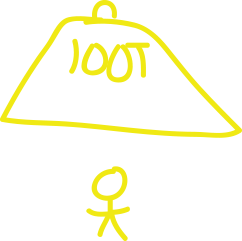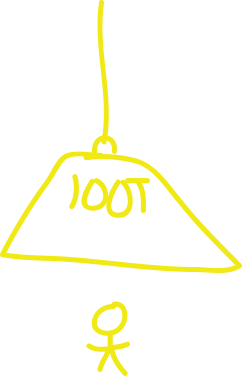Introduction
Picture Wars is a drawing game. The general premise of Picture Wars is this: First a character is drawn in the center by the defender. The attacker then draws an attack that will put the character in danger. The defender then must then either draw something that will counteract the attack or edit it if possible. Turns alternate.
These rules are made for one purpose: to ensure that Picture Wars is a constant battle of art, quick thinking, creativity, and ingenuity, that no person can create an ultimate, unconditional object to win a game. At first, when we started playing PW, there were no rules. But as we played more and more, we saw that there HAD to be an establishment of rules for guiding those to play. These rules are to keep the playing of Picture Wars an unexpected fun and unpredictable game. As long as you keep in mind that things aren’t always what they seem and you have a very creative mind, then you’ll make a great PW player!
Beginning the game
The game starts with a character drawn in the center of the canvass. The character can’t be too big to allow for space. The character can be anyone. A stick figure or whatever. The character cannot be invinicible however.
Attacker
After a character is drawn in the center, the game begins with an attack. The attacker’s goal is to draw a situation that the character will be doomed to death. The attacker has to use a different scenario each time or alter old scenarios. The attacker must kill the character to win which happens either if the defender cannot think of a way to neutralize an attack or a preset amount of time goes by with the defender not neutralizing the attack.
- The attacker cannot redefine the defender (an example would be coloring the head black and drawing a fuse to make it a bomb)
- The attacker cannot use any divine influence to ensure that the defender will lose
Defender
The defender must protect his/her character from the attacker by creating new objects or altering old objects to neutralize the attacker’s creations of destruction. As well as the attacker, the defender has to find a different way to survive the attacker’s scenario each time. The defender has to keep his character alive either for a preset amount of time, or until the drawing space is all filled up. Should either events occur, the defender wins.
After the defender makes their turn, it is the attacker’s turn again. This of course alternates.
- The defender cannot move to another place or change into another object to evade attack
- The defender’s character cannot take up a ton of space (preventing the attacker to have room for many attacks)
Textboxes
Both the attacker and the defender have something called textboxes (also called labels) that allow many things into the realm of Picture Wars. It simply lets you be more specific in the game. They can be very helpful. If someone uses one and it has no lines bordering it, it can be altered by adding words. You cannot cross anything out or add material if it is bounded. You also cannot have the textbox more than 8 words. The reason why is lets say that you want to label a bomb and in the label you say…
“Bomb that can blow anything up and if it’s disabled it will automatically home in on who it was disabled by and then unleash a napalm cannon that fries anything in it’s path including you. This bomb is also fissure proof, plug proof, on/off switch proof, tamper proof, water proof, basically ANYTHING proof. Let’s just say NOTHING can stop it.”
This is too tedious and unnecessary. It also takes up too much viable space that the attacker may need for future attacks.
Once an object is defined by using a text label, it cannot be redefined.
Time
EVERYTHING is frozen in time at the point of each person’s turn. Nothing goes in motion until the game ends. There is also no limit to how long some one can make a move unless otherwise determined before a game. What this also means is that you never edit anything to reflect time change. An example would be an attacker drawing an asteroid as an attack and then the defender draws a nuke to destroy it and then edits the asteroid to be blown up. You can’t do this.
Clarification
You can ask for more info if something unclear. An example of this is asking what an attack is supposed to do or how it works.
Short Example
- A character is drawn. (Preferably better to be drawn at the center for a better, involved game) No defenses can be made
because there is no attack. - The attacker draws a large weight above the character. If, by chance, the attacker fails to endanger the character, and this character has been out of danger for one turn, the defender wins.
- With the character endangered, the defender draws a cable holding up the weight, nautralizing the threat. (for now)



MODE 2 (Also used for multiplay)
Best used for message boards, this mode allows anyone to join in. A character is drawn like normal but then anyone can either attack or defend as long as it alternates. The same person cannot go twice however. (Attacks then defends)
Another version of this is teams. Two people could play the role of the defender while two could play the role of the attacker. The two would be able to exchange thoughts and ideas for their next move. This is recommended for a long game. 😛
Sample Games
Middle School Game – This occurred sometime in middle school.
First PWO Game – The first ever online PW game. I was the defender (in black) with someone else, the attacker, in red.
Via MessageBoard – In this game started on a message board, anyone could join in where people could be either the attacker or the defender
just as long as the standard rules were followed.